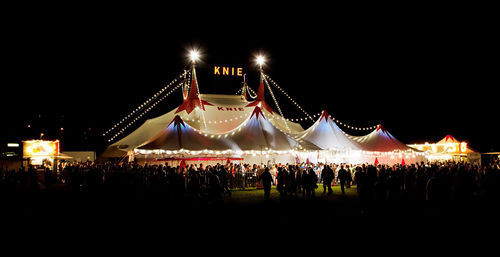Main Page
From Circopedia
|
In The Spotlight
CIRCUS KNIE (Established 1919)
When Friedrich Knie (1784-1850), the son of an Austrian doctor, fell in love with Wilma, a beautiful equestrienneA female equestrian, or horse trainer, horse presenter, or acrobat on horseback., in 1803 at Innsbruck, little did he know that this adventure would be at the origin of one of the world's most prestigious and long-lasting circus dynasties. Born in Erfurt and nineteen years old, the young Friedrich left his studies without a second thought and went on to roam the country with a small company of traveling performers.
Friedrich’s infatuation was short lived, but he enjoyed his new life as an itinerant entertainer, and he decided to create his own company of rope dancers, a craft he had learned during his tours. In 1807, he met and fell in love with Antonia (Toni) Stauffer. Toni’s father, a reputable barber, refused to marry his daughter to a traveling entertainer, and as a precaution, he sent her to a convent. As family lore has it, Friedrich abducted the object of his flame on a night of lightnings and thunder, and the two lovers got married that same year.
Soon came the family’s second generation of performers: Rudolf Knie (1808-1858) was born on July 14, 1808. Four more children followed: Georg (1809-1849), Karl (1813-1860), Fanny-Adelheid (1814-1857), and Franz (1816-1896). All of them would become rope dancers and acrobats.
The Napoleonic Wars (1803-1815) had rendered the political and social environment in Austria quite unstable, and the economic situation was uneasy. Yet, the family’s determination helped them overcome the many problems that a traveling company of performers had to face, especially in such difficult times. The Arena Knie was still a small affair that performed outdoors; the high rope was rigged above a stage, on which were presented tight and bouncing ropeAn rope placed between two supports or pedestals, and fastened at one or both ends to a spring or bungee, so that the ropedancer can use the rope as a propelling device. acts, along with an assortment of floor acrobatics and comedy turns. The addition of a few benches around the stage made up the arena.
Friedrich was smart, and one thing became quickly apparent to him: considering the situation, he couldn’t confine his travels to Austria. Germany was added to the route and, as early as 1814, Switzerland. In 1828, the Knies performed in Zurich for the first time, and that same year, in Rapperswil—which was to become much later, in 1907, their hometown. The Knie Arena developed into a successful and reputable enterprise in these three countries. (more...)
New Biographies
- Gia Eradze, Circus Director, Animal Trainer
- Rob Torres, Clown
- Tianjin Acrobatic Troupe, History
- Nino Frediani, Juggler
- Henrik Henricksen, Animal Trainer
New Videos
- The Pukhov Troupe, Porté-Lancé (1987)
- Gevorg Khachatryan, High Wire (2000)
- Priscilla Errani, Hula-Hoops (2015)
- Tamara Puzanova, Foot Juggler (1987)
- Yury Biryukov, Juggler (1953)
New Oral Histories
- Pinito del Oro's Interview on Spanish Television (1970)
- Gia Eradze's Interview on SSU TV (2015)
- Rosa Bouglione's interview on Franch Television (2012)
- A Short History of Madrid's Old Circo Price, Documentary (1970)
- Anastasia Dementieva-Kornilova – Vadim Vernik Interview (2017)
Circopedia Books
- Philip Astley & The Horsemen who invented the Circus, by Dominique Jando (2018)
A Message from the Editor
CIRCOPEDIA is a constantly evolving and expanding archive of the international circus. New videos, biographies, essays, and documents are added to the site on a weekly—and sometimes daily—basis. Keep visiting us: even if today you don't find what you're looking for, it may well be here tomorrow! And if you are a serious circus scholar and spot a factual or historical inaccuracy, do not hesitate to contact us: we will definitely consider your remarks and suggestions.
- Dominique Jando
- Founder and Curator
